#lyra hoop beginner
Text
I just completed 6 weeks worth of an Intro to Lyra course last night! I LOVED it and I'll be doing more!
#personal#for the moots#lyra#lyra hoop#plus size women#lyra beginner#lyra hoop beginner#lyra plus size#lyra hoop plus size
45 notes
·
View notes
Text
Very proud to have completed my first aerial performance after a year of training!!
#aerial hoop#lyra#aerial arts#aerial#choreography#lyra hoop#dont fear the reaper#dela-fe#aerial beginner#aerialist#baby aerialist
5 notes
·
View notes
Text
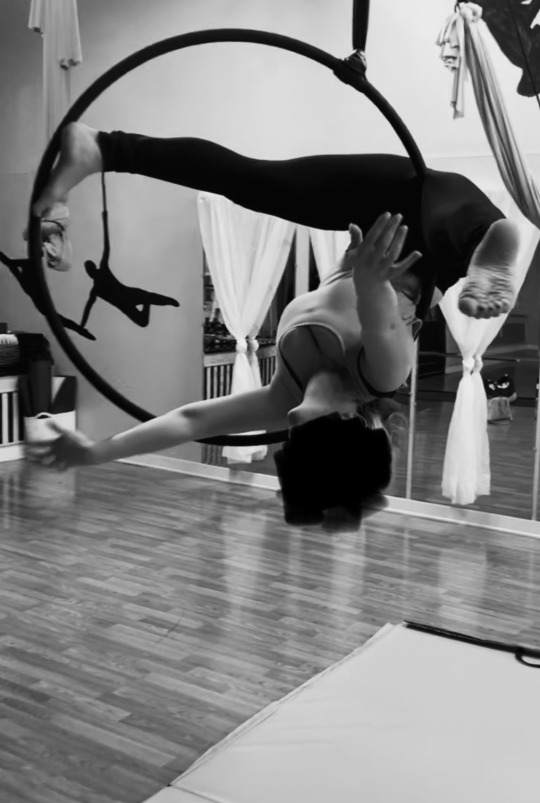
I can post this on an artsy type blog, right? Gotta get the serotonin to boost me enough to write and draw somehow. Aerial arts is the key for writers and artist block. Spread the word.
#aerial lyra#aerial hoop#beginner aerialist#aerial arts#all the weight I’ve gained is ever so present in this photo#she is beauty she is grace she is fat as fvck#but she does kind of cool things sometimes
1 note
·
View note
Note
I'm usually horrible at these things because I never know what to ask, so thank you for the nifty list. XD My question because I love seeing your pole videos -> What made you decide to get into pole fitness?
that is why I made the list, bc I'm also horrible at coming up with questions 😂
anyway. for anyone who is unaware, I post a weekly pole video on Instagram after my pole fitness class. like honestly I do that more predictably than I post about my books lmao.
[I'll add a link to my latest reel when I'm back on desktop, since on mobile the phone's menu blocks the link button when I highlight the text.]
okay so how I got into it:
I had a work friend who does aerial silks (among other things), who invited me to the showcase at the studio she teaches at. something I loved about their showcase was the body diversity, especially in the pole, burlesque, and chair routines. like!! you've got all these plus-sized women looking sexy and confident as hell, and I was like, I want to feel that way.
so after the second showcase I went to, I stopped by my friend's office like "I'm thinking of trying a pole class," and she INSTANTLY grabbed her phone, texted the beginner pole instructor, signed me up for a drop-in class, and said "no more thinking, now you just have to try it :)"
which btw was very effective, like I'm convinced I would've tried it eventually but it probably would've taken another six months of careful consideration bc that's how I generally am.
instead, I went, and I've gone every week since. it's been like 10 months now, and I've also tried a Lyra (aerial hoop) workshop and a pole choreography class, plus helped out with pole demos at Pride, plus go to a free monthly Latin dance night my instructor hosts downtown with a friend from the local ballroom company.
it's the most in tune I've ever been with my own body (ever a work in progress, but we're getting there), plus the best I've ever felt about my body.
on that note, have a thirst trap that a different platform marked as "suggestive content," which is the first time that's ever happened to me lmao

I said my thirties would be my hot girl era, and so they are 😤
12 notes
·
View notes
Text
I've been too depressed to move or leave the house for weeks. I had signed up for a beginner's aerial class back in fall, before the seasonal affective disorder really kicked in, and today was the first class.
Even though I had timed it so I would be there 20 minutes early, I ended up 40 minutes late because I was stuck in traffic for almost a full hour because of an accident.
I came in with only a few minutes of the class left. Wearing ill-fitting workout gear, other students staring at me, teacher flustered because I had shown up so late and she couldn't restart the lesson.
I learned just a few basics, how to get into a lyra hoop and out again, how to sit in it and do a simple hang.
I bruised the hell out of my tailbone. I kept swinging the hoop by mistake. I didn't look as graceful as the other students. My shirt kept riding up. I took a short video of myself, and I looked overweight and clumsy, a clear amateur.
...
But I did it.
18 notes
·
View notes
Text
Fitness journey post #2
Just wanted to update you ladybugs on my fitness. I added headstands because i bought a yoga stand like 5 years ago when i really started trying to get into fitness. Unfortunately I've failed at that fitness goal. I had a planet fitness membership and went the first 4 or 5 months then just stopped. Had a Barre membership and the same thing happened. My grandfather past away so my depression spiked.
The good news is that I've been consistent for 2 weeks now. I just want to tell yall its ok to not be perfect. I just took a little walk around yesterday instead of my workout. Any movement gets you closer to that goal. Ultimately we can fail or succeed its up to us to decide how long we stay up or down. No step is too big or small if its comfortable for you. Life is at your own pace. Do not compare your journey with others. Do/be your best. All of the rest of the clichés that I can think of insert here. Its a cliché for a reason, means its true. Not every inspirational quote has to be unique.
Im exhausted tonight. I worked out hard today and day 2 of trying to do a headstand. My arms are pretty weak so those legs aint up yall! To make up im adding pushups in the hopes it gets my arms stronger. Im still doing Barre and Stretches! I added hip hop tabata and im loving the fast pace. Im also trying to condition my body so I can transition into Lyra Hoop. (Thats a year or two out thats why its not in my hobby post.)
My Weekly Workout Plan for 2 months:
11 minute: Stretch (Ballet)
30 minute: HipHop Tabata
30 minute: Barre Full Body Workout
23 minute: Stretch (Aerial Beginner)
4 minute: Easy Headstand 1st steps
10 wall pushups, 60 sec plank
Try out these workouts, they are all on youtube. You could also just do a video a day. Im not strict i do them out of order or break it up.
I hope tonight is peaceful for you. Im going to enjoy the rain now that im fresh out the shower. Absolutely nothing beats falling asleep to the sound of rain.
Good night Ladybugs,
🐞 Kimie
1 note
·
View note
Text
Acrobatic Classes and Workshops for Kids
Whether it’s walking on the tightrope or juggling, kids with an adventurous spirit can now develop circus skills at their local gym. Kids Circus Perth offers classes through the week and workshops in school holidays.

Weekly acrobatic classes perth are a fun, energetic and highly demanding sport that incorporates both ground and aerial stunts. Students must memorise complex routines and build strength, flexibility and balance.
Acrobatics
Acrobatics is a gymnastic-based dance that strengthens the body, helps with balance and flexibility. It also builds self-confidence and motor coordination. It’s often combined with other forms of creative movement, such as dance or cheerleading.
Acrobatic traditions are found in many cultures, including China, Egypt and Greece. Some acrobatic skills are rooted in martial arts, while others are used in performance art and circus acts. It was not until the late 19th century that acrobatics became a competitive sport, with the invention of the flying trapeze and Charles Blondin’s crossing of Niagara Falls on a tightrope.
The basics of acrobatics can be learned by anyone, ranging from beginner to advanced levels. These can include forward and backward rolls, cartwheels, limbers and beginner balances. The more advanced students learn partner lifts and stunts.
Aerials
Infinity Aerial Academy is showing the Morley neighbourhood that aerial arts are harder than it looks. They offer a range of aerial classes including silks, fusion, yoga, conditioning and all-rounders. Their instructors are all aerial artists, acrobats and allround dead-set legends. Their classes are fun and challenging, perfect for those who want to tone and sculpt while having the time of their life.
FlyGym Aerial Fitness offers a variety of classes to suit every skill level, age and body type. These classes combine traditional strength, endurance and power training with fluidity, stability, release and flexibility.
Aerials classes are a great way to build upper body and core strength while learning exciting tricks on trapeze, hoop, silks (aka lyra) and rope. These skills look stunning and appear effortless when you’ve conditioned your body properly.
Juggling
Juggling is a skill that requires tremendous dexterity. The basic technique involves throwing and catching objects in the air without them touching the ground. This includes toss juggling, where the objects are thrown straight up in the air, and bounce juggling, in which the object bounces off the ground before being tossed.
It has also been proven that juggling can help reduce stress and depression. The act of juggling increases blood flow, strengthens the brain’s cognitive pathways and improves concentration. It has even been linked to the prevention of Alzheimer’s disease.
Acro Kids offers fun, energetic, non-competitive recreational gymnastics and parkour classes for babies to teens. Students learn acrobatic classes skills like handstands, cartwheels and flips in a safe and supportive environment. The program also teaches juggling, stilt walking and unicycle.
Unicycle
A unicycle is a single-wheel vehicle that requires balance and strength in ways that riding a bicycle does not. The rider can learn several tricks once basic riding is mastered. These include idle riding, turning (putting the arm of the direction they want to go behind them and the other in front of them), and jumping.
Unicycles come in a variety of sizes and are shaped differently. Some are rounded and symmetrical, while others are straight and padded. They are typically geared with one wheel and can be ridden in forward, backward, and even on one foot.
Beginners can learn to ride by standing beside a support and rocking back and forth until the pedals are about horizontal. They can then hop on with their dominant foot, and push down with the other.
Stiltwalking
Stilt walking is a fun and challenging way to exercise your body. It also helps build balance and coordination. However, you need to be very patient when learning this skill. Practice regularly and you’ll be amazed at the results!
Stilt walkers perform in parades, events, and street shows. They are usually dressed in costumes and perform dance routines or walk on stilts while turning. They can also sing or vogu. They may also play drums and cymbals.
When practicing on stilts, find an objective to reach and work towards it. Then, move on to more difficult terrains. For example, start on pavement and then progress to stairs that have railings or walls next to them. This will give you something to steady yourself against and prevent the tendency to turn without thinking.
#acrobatic classes perth#acrobatic classes#ballet dance classes#tap dance classes#tap dance classes perth
0 notes
Text
Metaphor Storytime!
This will happen occasionally, because as I'm sure those of you with it know, ADHD brain processes literally everything by patterns and association. So let's talk about some of my metaphors for life. Today's story is Do the Drop.
Ok, so over the past 10 years just about, I have trained off and on in circus, mainly focusing on clowning and props, balancing, aerials, and basic strength/weight training. I say on and off, because I'm incapable of forming my own routine, and classes and/or personal Trainor sessions are... Financially unattainable, at times. Anyway, when I can afford to be training, I like to say that I do clowning and balancing for the bread (I also street perform once in a great while, so these are the things that put bread in my stomach. Not to say I don't enjoy them; they're a ton of fun, but my One True Love in terms of circus art is just elsewhere), and aerials for the heart (I don't care if having the skill and setup to be a legit performer ever comes to form; I go to the classes simply for the enjoyment of touching hoop and fabric and getting my feet off the ground on a regular basis. The act alone brings me joy).
There are certain tricks in aerial performance called "Drops". These are the ones where you set up by wrapping yourself in fabric or rope, or hang yourself over the bottom of the hoop or bar of the trapeze, and then let go and look pretty as you trust gravity to do the work. There are drops that spin you into front flips, slide you down like a fire pole, even drops (especially on the hoop) where you straight up just let go and grab somewhere else. An example is a trick I learned as the "Chandelier Drop" on the Lyra hoop— simple, yet complicated. You start from an inverted hang off the top, between the points if you're on a 2 point hoop (which is fancy for saying hanging upside down from your knees at the top, between the parts where the rope is hooked on 😛). To prep, you reach down for the bottom of the hoop, hold it straight out slightly in front of you without locking your elbows (so the hoop is tilted and not pointed directly at the floor— you're vertical and upside down), unhook your non- dominant leg from the hoop, and stick it out in front of you at a 90° angle or less toward the floor (so yes, you're hanging by one leg, with the other kicking straight out in front of you), and tilt your head back so your chin points toward the floor.
Then to do the drop, you just let go of your other leg. in the few seconds you're in the air, your second leg swings forward to join the first, and your hands keep the bottom of the hoop from hitting you in the face while guiding it safely into your hips. You end up in a hip-hang, piking your legs straight in front of you and holding the bar with bent elbows, essentially looking like you're sitting in a chair upside down with a safety belt across your lap. Simple— the drop itself is one step; just let go and the next thing you're aware of is that it's already over. Let go, kick, protect face, done. Complicated— the setup is very precise; if your legs are just slightly too open or you hyperextend your elbows without thinking, you could fall out of the hoop, and if your grip fails there, you could be falling face-, neck-, or tailbone first. If you're not holding the bar firm enough in place, it'll swing back directly under your head and you'll end up with a black eye or a nosebleed at the very least; if you try to hold it too firm, the bar will land on the straight of your thigh instead of the crease of your hip, and you'll end up with some bruised femurs and a very awkward front flip or invert (any time you're upside down— this time from your hands, like a very crooked Olympic rings competitor).
So where's the metaphor for life come in? Right, I'll get to the actual point. When I first learned to do beginner drops, like the Chandelier, I had problems where I would freeze at the top and not be able to let go. I was so afraid of that dead weight falling sensation and all the things that could go wrong, that I would make sure I set up perfectly, but then I physically could not open my hands and let go of the bar (or the hoop, or the fabric). I was just... Frozen, suspended, the perfect living depiction of the archetypal Hanged Man card from a tarot deck. This locked up, instinctive hesitation was, in itself, dangerously unsustainable— these setup positions are not designed to be held indefinitely, and they're not considered secure or resting positions. If I don't let go with that knee eventually, the blood will rush to my head and I'll pass out; if I don't choose to open my first on the fabric soon my hand will get sweaty and tired and I'll slip off of it anyway. If I try to baby my way through it or slow down the fall to process it in real time, I could put more stress on my palms or hips or muscles than there should be and get too fatigued to make it to the ground safely, or give myself horrible rope burns or bruises that will take weeks to heal, or even sprain or dislocate a joint. Sometimes my anxiety is the armor that keeps me safe from very real dangers around me, and keeps me prepared for things that aren't planned for; this time though, that same anxiety is my mortal enemy, and if I allow it to have any space in this moment at all, those dangers that it wants to point out and prepare for indefinitely will come to pass. Sometimes it's fundamentally required that I put life on pause, give my fear or grief or discomfort attention and space to exist, and let them wash over before I can healthily move forward; but the only thing that letting those emotions do all the talking for me will do in this moment is make things worse. In order to safely do the drop, in order to get the extremely satisfying and rewarding rush of adrenaline and dopamine from completing the trick, I have to tell them to shut up for a second and wait til it's over to talk. I have to empty my brain, stop thinking, and just Do the Drop.
This is.... Not only foreign, but completely contradictory to the nature of how my brain works. I'm ADHD; there is no off switch to the voices in my head. I have general anxiety; everything is scary, especially the things I don't know about yet, so I have to imagine all of them and plan for every single one. "Just be quiet and wait til after" is not something my rambunctious toddler of a nervous system can just do. So how do I get it to let me do the fun thing?? I trick it, by using its own functions against it. See, another feature of ADHD is that it comes with both future blindness and object impermanence, the result of which is essentially that anything outside of the next 24 hours is a physical object I cannot see and therefore cannot functionally process the existence of. ADHD folks have trouble setting long term goals because of this; there is no timeline, there is only "right fucking now" or "perpetual later", and there's no pathway between them to move things back and forth. We end up procrastinating things we don't want to do because they are only ever on the distant horizon until they are suddenly right on top of us. There is no watching them approach; there is only seeing these things teleport directly from there to here. If this sounds to be a direct paradox with those ever present voices of fear that have to make us imagine and plan out every single thing before they happen, that's because you are correct— they are complete opposites. They happen at the same time. We're just as scared and confused as you are. Basically, one is a process that involves the "theory" of planning, or the creativity and racing thoughts we're always teeming with, and the other is the "practical application" of it, or performing the executive function of things like processing time and delaying gratification. For us, they're separate parts of the brain.
Getting back to that Chandelier drop on the Lyra hoop from earlier, now I know what's currently happening— the imagination and emotion parts of my brain are turned on and using too much power— and what should be happening instead— the executive function and physical movement parts of my brain should be turned on and doing most of the work— and what that looks like in terms of what my brain is doing and not doing— imagining all the ways I could die vs. moving and protecting my body. So now I can manually, consciously turn off the anxiety symptoms and turn on the ADHD symptoms, which goes a little like this: ok, what am I doing right now? Well I'm setting up a drop and I'm letting go of the hoop and I'm hitting myself in the face or falling on my neck or looking stupid and ungraceful when I mess up or— nah, stop that. I'm not actually doing all of that right now. I'm just doing this one thing. Wanna know what it is? I— but— o-oh? Ok... Cool. All I'm doing right now is kicking my left leg. ..... O-oh. Yea. It's super easy, look, the arms and the chin and the extra leg stuff are already done, they're cool. I'm just doing the kick thing right now. But.... What happens after? Lol fuck if I know, dude. I have zero forsight. Anyway, time isn't real, so I'm just gunna go ahead and do it now. ONE, TWO, THREE— >~~<;;;........ >~~0 oh. It's.... It's already over. We survived. Yep. Neat, huh?
I have this internal conversation between Anxiety and ADHD, of course, preprogrammed and compressed into a single, split-second command function for efficiency and automation. When I consciously "input the command" or think to myself, "Do the Drop", my brain instantly switches gears as if it's already had this conversation with itself— the executive function and physical movement parts switch on and take their required energy, which forces the emotional and creative sections to switch off. When I tell myself "do the drop", I go through a mechanical process that is linked to the countdown— look straight ahead, deep breath in, transfer thought to muscular impulse. Blink. Action complete. And before I know it, I'm already sitting in the end position. I don't want to say that I close my eyes, or describe it as blanking out or dissociating, but essentially I've learned to do just that in a safe and controlled way. I can only follow through on the mechanical action if I turn off every unnecessary function of my mind and let my muscles and joints themselves handle the instinct to keep me alive. Once I've transitioned from one secure position to the next secure position, there is only the real result of the past action to process, rather than the projected outcomes of the future; all I have to sort through now is counting up how much strength I have for the next action and distributing the adrenaline that's now in my veins evenly so I can still breathe. Those are things I can already see and touch, those are things I know, they're a lot less scary than the things I don't.
So I come to the end of my story, and bring this all around to my overly complicated metaphors that get me through daily life. Sometimes, things transition from one state to another. Those things on the "later" horizon inevitably appear in the urgent "now" one day. Weather we're aware of these things in our logical mind or not, our emotional mind can only ever handle them one way, as they happen in real time— I may have known for months that my roommate has dreamed of moving to NYC since he was a kid. He may have said to me, point blank and completely bare, "I am moving out in 6 months". These things have been documented by my conscious mind. This documentation means jack shit to my feelings mind. My feelings mind is the shelter cat with weird neurotic quirks I have to be careful of, and while I understand what's about to happen, it's completely unreasonable to expect this animal to understand and behave accordingly. It is only capable of being aware of the present, and is only capable of defending itself from the real things in its environment. So currently, I face a choice: move that scary transition to the "Now" box before it happens, and shut my life down indefinitely as my anxiety runs wild with mapping out all the bad things that could happen and are likely to happen, or allow my ADHD brain to keep ignoring all of it in the "later" box until I'm watching old roomie drive away and watching new roomie use our bathroom in the mornings, and deal with the overly intense and dysfunctional negative feelings as they hit in real time. As with this event in my life now, I have faced this imperfect decision of choice between suffering panic now or suffering despair later.
So the moral of the story is this: sometimes, anxiety is a silent helper. Sometimes, Anxiety is little red riding hood's parents telling her that the rules are to stay on the path no matter what and don't stop for anything until she gets to granny's house. Other times though, it's just the Shepard boy who came running into town shouting about a wolf that wasn't there because he had nothing to keep him occupied. I've learned that there are times when it's rewarding and fun to challenge my anxiety, like when I want to chase that high from doing an aerial drop, or when I want to go out into the city and watch people in a busy cafe. Sometimes, life throws something at me that I can't possibly realistically plan out ahead— and in fact, it may be incredibly unhealthy to let myself do so. It's much less damaging and disruptive to my life to force myself to take these changes as they come. In other words, sometimes there are times in life where I just have to take a deep breath and tell myself... "Ok. I've never experienced this, and I have no template to plan for it. Yeet, motherfucker, let's Do this Drop."
#adhd#mental disability#mental health#personal journal#personal experience#baby steps#dealing with emotions#sudden changes#life#story time#long post#rambles#essay#aerials#metaphor
3 notes
·
View notes
Note
This is sort of a weird question (ignore if you don't wanna answer), but I'm writing fanfic about a comic book character who's an acrobat. Idk anything about acrobatic stuff but a mutual told me to ask you. Any tips/insight? Sorry this isn't about DP specifically...
I’m going to go out on a limb and guess that this is either about Nightcrawler or Nightwing? I’m also curious as to who this mutual was lol there are very, very few people on tumblr who would know to ask me this question.
Regardless, I’m happy to help.
Fair warning, I’m just going to cover the basics and I’ll probably forget some stuff. Also, when I talk about “circus” or “circus arts” I’m referring to lyra, silks, trapeze arts, cube, etc specifically (the aerial arts). I’m guessing since it’s a comic book and since you’re asking me you want answers catered to that - so if I say something about an “acrobat” I’m using it interchangeably with “aerialist,” but acrobat can encompass other disciplines as well.
Stuff about aerial arts equipment:
- There’s three (general) types of apparatus: a lyra (basically a steel hoop, sometimes with a bar across the top of it and they’re usually taped), silks (two pieces of fabric that vary in stretchiness; can be tied to create a sling or hammock and the stretchiness of the fabric will alter your approach to it), and trapeze (can be standing or flying). There are more, but these are the three that people are probably most familiar with.
- Rigging is an art form in and of itself. Aerialists have different standards when it comes to what they’ll accept as “safe,” but in general the standard is “if it can’t hold a truck, it can’t hold me.”
- People usually have a favorite apparatus. This seems to revolve around 1) what type of pain people are willing to put up with and 2) what makes “sense” to someone conceptually; aerials often involve weird, upside down movements and you need to be able to visualize placements and move your body appropriately. Sometimes people have an easier time doing this with one apparatus compared to another.
Stuff about aerialists:
- Circus hurts. I think the biggest thing that people don’t realize is how physically painful and damaging aerial arts can be. The lyra, silks, trapeze, etc can all leave a lot of really intense bruises and burns. It’s super common for aerialists to have strange, ugly bruising and/or rope burn all over their body from the equipment itself. The injuries vary depending on the apparatus someone uses, but everyone who does aerials has them. It’s more common for beginners but even experienced aerialists get them when trying new things or if they’ve taken some time off.
- Experienced aerialists have thickened/leathery skin at various pressure points on their body. It develops over time as your body adjusts and builds layers to combat tissue damage (see previous point). The most common areas are places like the top of the feet, back of the knees, palms, hips, and armpits, but it depends on the apparatus the aerialist uses. I’m not saying that someone can tell just by looking at an aerialist that they have thickened skin (it’s not grossly obvious or anything like that), but you can usually feel it.
- In terms of build, aerial arts are as much about endurance as they are about brute strength. Because of that, many aerialists are fairly lean (think of a build like a lean gymnast or a ballerina). Any type of aerial art is a full body workout, but aerialists tend to have very strong hips, abs, shoulders, backs, and arms, including forearms; if there’s one consistent thing I’ve seen across aerialists, it’s broad shoulders and muscular forearms. Still, people of all different body types can be incredibly successful aerialists/acrobats, so if you’re writing a story involving acrobats don’t be afraid to make the acrobat have whatever body type you want.
- The rumors are true: flexibility is very important in the circus arts and aerialists tend to be very flexible. Having said that, being too flexible is just as much of a problem as being too stiff; if you can over-extend, it will “look” pretty because it leads to cleaner lines, but there’s also an increased risk of injury and “floppiness”. Basically, the more flexible you are, the more control you need to have in the air.
- I think people sometimes confuse bravery with recklessness. Aerialists are very brave; I’ve never met an aerialist who is reckless. Being an aerialist requires a pretty strong mind and a sense of self-confidence but rarely do aerialists take needless risks.
- Aerialists/acrobats are among the most welcoming people in the world. Aerial arts is a real adrenaline rush, so I guess everyone could just be high… but I’ve never met a “mean” or unfriendly aerialist. It’s definitely a family.
What the sport is like:
- The aerial arts are very difficult. Most people understand that conceptually, but nearly every beginner underestimates how tough it is or overestimates their own strength. There are muscles that can only really be worked through aerials. Most true beginners take several days just to be able to hang off of an apparatus for an adequate amount of time. That’s not to say that beginners don’t get “in the air” on their first day, but they’re rarely more than a few feet off the ground. Part of this, too, is because beginners don’t have technique - a lot of aerial is about proper technique.
- I think what people underestimate the most is the amount of grip strength you need. The vast majority of beginners will lose grip strength long before they lose shoulder strength when they’re first starting out; I’ve seen people who have incredibly strong backs/shoulders but struggle with the silks because they don’t have the grip strength for them.
Some aerialists will use sprays or powders to increase their grip strength; this is a huge point of contention in the aerial community. If you ever want to open a can of worms among aerialists, ask them their opinion on the use of rosin. It’s banned in some training centers and encouraged in others - people can get very, very heated over it.
- For reference, in my experience a typical training practice can last anywhere from 1.5-3 hours, but you don’t spend the entire time in the air. Practice is usually anywhere from 1 to 3 times a week, potentially more if you’re training for a performance. Conditioning is serious business and is typically done before practice, but sometimes training will finish with “last actions” which is basically conditioning when you’re exhausted. Fatigue is a real issue so I’ve never seen anyone train everyday.
I think that’ll cover the basics if you’re designing an aerialist/acrobatic character or building a story for one, but let me know if you have any other questions! And if anyone has stuff to add feel free to comment.
32 notes
·
View notes
Photo

Looking for a fun and safe way to start your New Year’s Day? We have classes all day tomorrow! 9 am - All Ages Lyra Aerial Hoop 10:15 am - Lyra Level 2 11:30 am - Aerial Hammock for Beginners 12:45 pm - Hammock Level 2 (at Flexibility in Flight) https://www.instagram.com/flexibilityinflight/p/CYKpoaCFTsX/?utm_medium=tumblr
0 notes
Text
Final week of my Plus Size Lyra series! I'll be retaking Intro to Lyra now and then moving up to Lyra 1!
#lyra hoop beginner#lyra beginner#lyra plus size#lyra hoop#lyra#aerial#plus size women#plus size aerial#aerial arts#plus size aerial arts#all bodies can do aerial
11 notes
·
View notes
Text

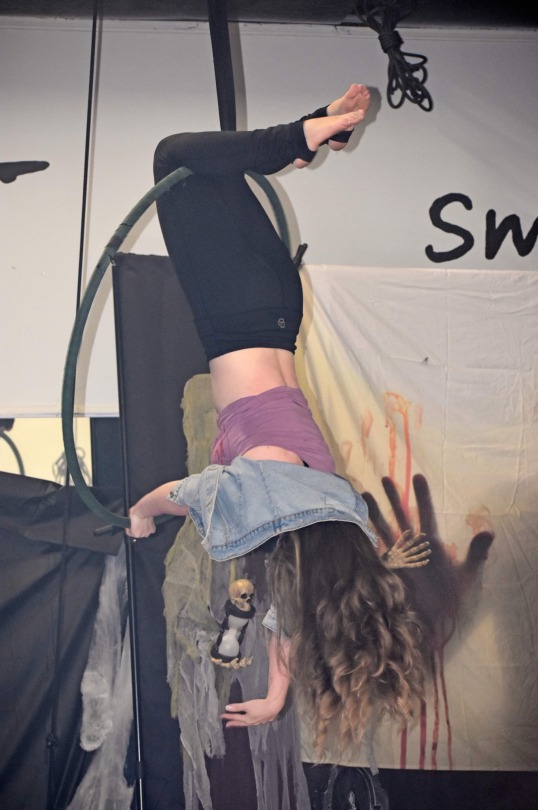

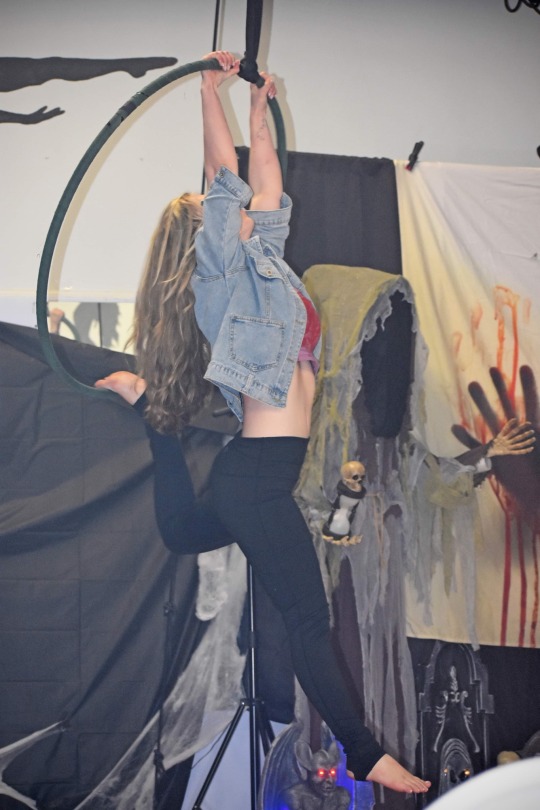

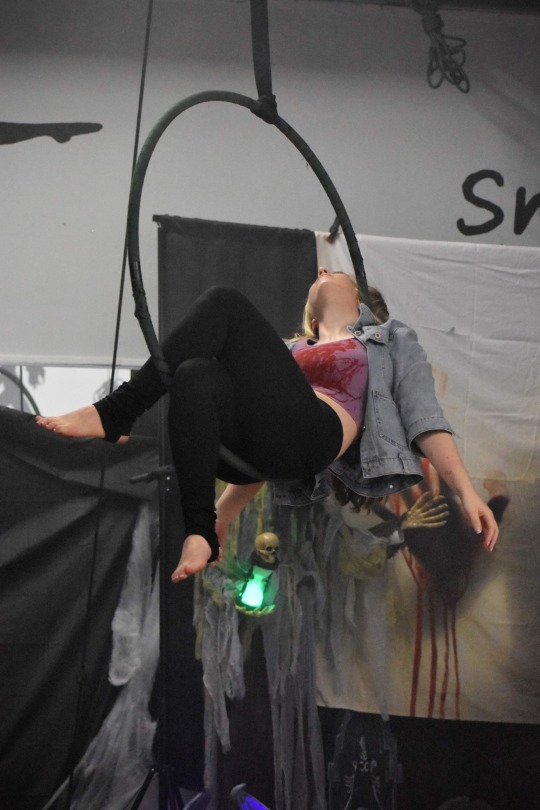
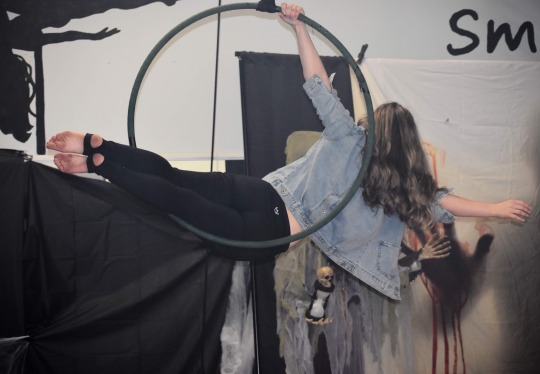
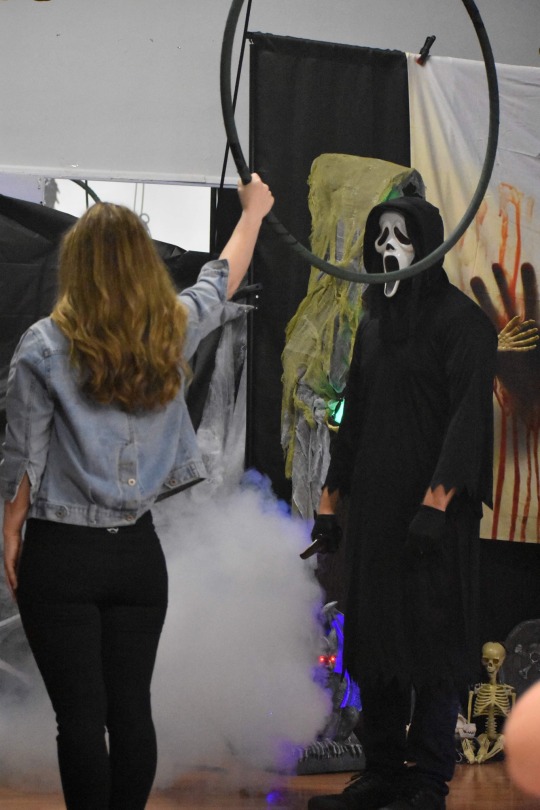
Still shots from my first aerial showcase this weekend 🥰✨
1 note
·
View note
Photo

Aerial Equipment Gift Cards / Gift Vouchers Variable Value $50 $100 $250 $500 Aerial Supplies Australia The Ultimate Aerial Equipment Gift-card (beginner to professional) The Aerials Australia Aerial Equipment Gift Cards can be used on any product in the Aerials Australia Store including Aerial Silks, Aerial Yoga Hammocks, Aerial Bungee, Aerial Rigs, Aerial Lyra Hoops, Aerial Rigs any many other products.
0 notes
Photo

Just Pinned to Pole Dance Magic Posts: How to learn lyra hoop? https://ift.tt/2mNV5Yj Want to learn the art of the Lyra hoop then we have a few options available for beginners to get their start in the sport https://ift.tt/2nbKEhK
0 notes